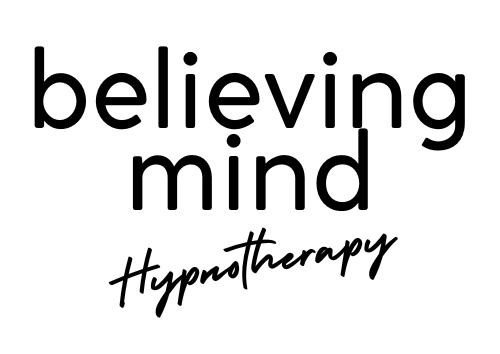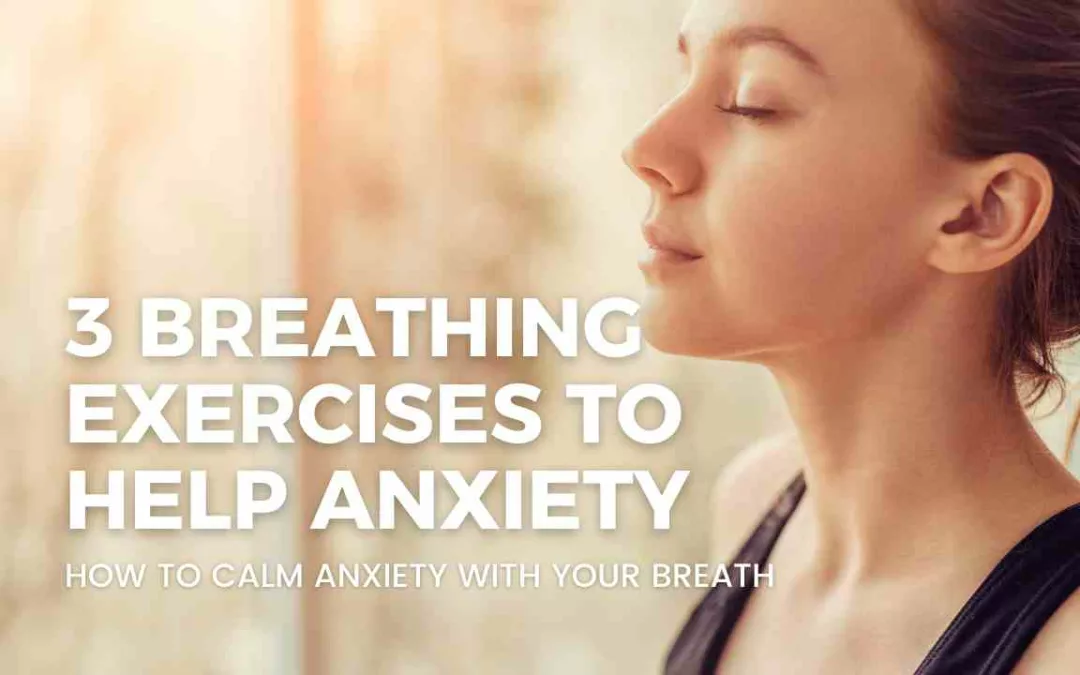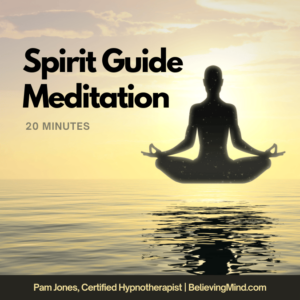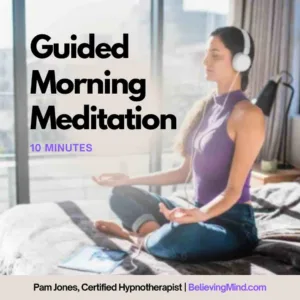When I first started taking yoga classes 18 years ago or so (has it been that long?!?) I had a hard time when the instructor would tell us to “connect with the breath”.
She’d say “inhale deeply through your nose, feeling your chest and belly expand…and then exhale slowly from the mouth”.
But it seemed like the MORE I focused on my breath, the MORE I started to feel anxious about keeping up with her directions…and started breathing faster to keep up. Next thing I knew I felt like I was hyperventilating!
I’ve since learned that I was trying to control my breath to her count, and should have listened to my body. When you breathe too fast, you are actually creating a state of anxiety in your body.
After awhile I learned to flow my breath with my movements in a way that felt comfortable for me, and that made all the difference. It’s pretty remarkable how something as simple as BREATHING can calm your anxiety, but it works when it’s done correctly!
Here’s why breathing exercises calm anxiety:
Whenever you feel anxious or stressed out, your breathing automatically becomes more shallow and fast. This is because you’re in a “fight or flight” state, engaged by your sympathetic nervous system.
There are various muscles that help to control your lungs along with your Diaphragm – a very important muscle located under your lungs.
So when you’re taking short little breaths, you aren’t engaging your Diaphragm, like you should be.
Your diaphragm is connected to your Vagus Nerve. This is a very important nerve that runs down from your brainstem, down your spine into various organs in the body. It’s the main component of the parasympathetic nervous system, which controls your stress response and calms you down.
I like to think of the Vagus Nerve as the calming center of the body. You want to activate this nerve to feel calm and at peace.
Breathing exercises such as Diaphragmatic Breathing engage your Vagus Nerve, which will deeply calm and relax you! This will take you out of that “fight or flight” state, reducing stress and anxiety. It’s also been shown to help manage pain and fearful situations.
It’s best to practice breathing exercises daily, to train your body to automatically respond positively to stress.
Your body will be better able to regulate itself when you get into a stressful situation if you’ve been practicing breathing exercises daily. It’s best if you practice these breathing exercises at least 3 times a day. Next thing you know, this will become automatic for you!
Set a goal for yourself to do breathing exercises for the next 30 days and watch your anxiety and stress decrease.
Ready to give it a try? Let me share 3 different breathing exercises that are simple and effective. Just start with one today and practice it for the next week or so, 3 times a day. After you feel comfortable with that breathing exercise, move on to the next one, and so on.
NOTE: If you have any medical conditions, please check with your doctor before practicing breathing exercises.
BREATHING EXERCISE #1: Box Breathing (4-4-4 Breathing)
- This exercise can be performed sitting or standing, whichever is easier for you.
- Consciously relax your shoulders back and down, and breathe in and out through your nose. Begin to focus on how you are breathing. You may close your eyes to feel more in touch with your breath.
- On your next exhale, breathe out for a count of 4.
- Hold your breath out for a count of 4.
- Inhale for a count of 4.
- Hold your breath in for a count of 4.
- Repeat this process of breathing to a count of 4: breathe in, hold, breath out, hold.
- Continue for a few minutes. It’s best to practice this breathing exercise several times a day.
Box breathing is the perfect breathing exercise for beginners. It helps you learn how to focus and control your breath, which will help you with more advanced breathing exercises. It is great at lowering heart rate and reducing anxiety. You can do this anytime you are feeling stressed, overwhelmed or anxious!
BREATHING EXERCISE #2: Lengthen Your Exhale
- This exercise can be performed sitting, standing, or lying down, whichever is easier for you.
- Consciously relax your shoulders and breathe in and out through your nose. Begin to focus on how you are breathing. You may close your eyes to feel more in touch with your breath.
- On your next inhale through your nose, slowly breathe in to a count of 4.
- On your next exhale, slowly breathe out to a count of 6. You should feel as if your lungs empty before your next inhale.
- Repeat this for a couple minutes. When you feel ready, increase the length of your exhale even more.
- On your next inhale through your nose, slowly breathe in to a count of 4.
- On your next exhale, slowly breathe out to a count of 8.
- Repeat this for 5 minutes. It’s best to practice this breathing exercise several times a day.
This breathing exercise works as your parasympathetic nervous system is activated during your exhale, and by lengthening the time you are exhaling, you are calming your anxiety and increasing your ability to feel relaxed. This is a great technique that you can use anywhere you are feeling anxious and need to calm down. I like to use this with my hypnotherapy clients to prepare them for their hypnosis session.
BREATHING EXERCISE #3: Diaphragmatic Breathing
- Sit comfortably in a chair with your feet flat on the floor. You can also try this lying down, if that is easier for you.
- Consciously relax your shoulders and breathe in and out through your nose. Begin to focus on how you are breathing. You may close your eyes to feel more in touch with your breath and using your diaphragm during this exercise.
- Put one hand on your upper chest. Place your other hand on your upper stomach, which is where you diaphragm is located.
- On your next inhale focus on breathing into your stomach, and feel your lower hand on your diaphragm move. Your lower hand should move out as you breath in, while your hand on your upper chest should remain relatively still.
- On your exhale, gently tighten your stomach muscles inward and exhale your breath through pursed lips (slightly puckered like you are blowing a kiss or blowing bubbles).
- Continue for 5 minutes. After this becomes comfortable for you, increase the time to 10 minutes. It’s best to practice this breathing exercise several times a day.
During each inhale and exhale, your hand on your diaphragm should be steadily moving out and in, while the head on your chest remains steady. You are training your body how you use your diaphragm to breathe, which activates the vagus nerve, relieving stress and anxiety. This is especially helpful for lowering blood pressure.
Looking for more ways to calm your anxiety?
Download my FREE GUIDED MORNING MEDITATION.
Hypnotherapy is very effective!
Simply being in a state of hypnosis gets you out of fight or flight state and is a major anxiety reliever. I can also teach you how to do self-hypnosis at home, as well as Emotional Freedom Technique (EFT) which is also known as “tapping”, so that you can be in control of your anxiety.
Request information on hypnotherapy sessions here!
Know anyone who is stressed out and would love to try these techniques? Please share this post with them!
My best to you,
Pam

My name is Pam Jones and I live in Richland, Washington (Tri-Cities). I’m a Certified Hypnotherapist and Therapeutic Imagery Master. I’m passionate about helping people overcome obstacles holding them back from living an abundant, healthy, and happy life. Reprogram limiting beliefs in your subconscious mind with hypnosis, so that you have the confidence to pursue your dreams without the fear of failure and negative thoughts. I do online hypnotherapy sessions and use a variety of methods with clients, which include hypnotherapy, therapeutic imagery, past life regression, and emotional freedom technique/tapping (EFT). My hypnotherapy certifications and specialities include anxiety & fears, stress relief, healing the inner child, sleep, weight loss, smoking cessation, and sports performance.




